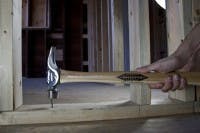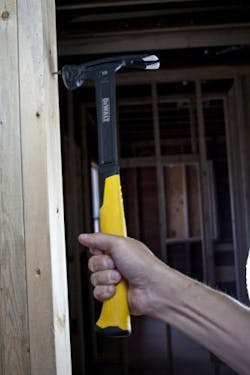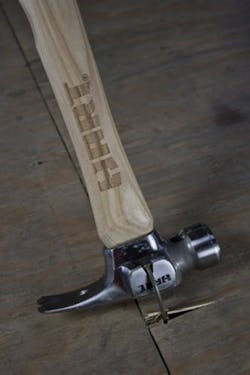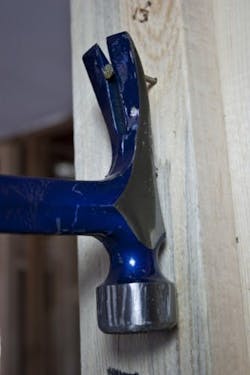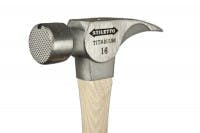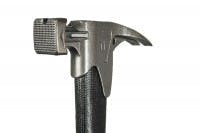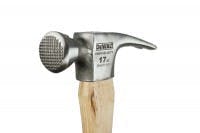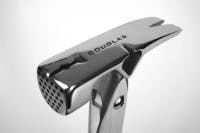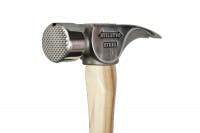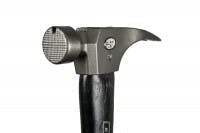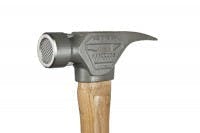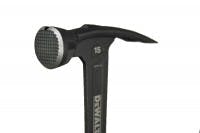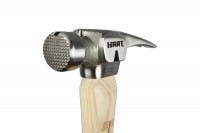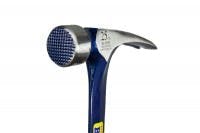Head2Head Tool Test: Framing Hammers
A subjective exploration of 11 'lightweight' heavy-hitters
Ed's Note: This comprehensive tool review is reprinted with permission from ProToolReviews.com, a comprehensive tool review website, as the name infers. If you are a tool junkie, you should go there and dig through their ditches. There's a lot.
Arguably one of the oldest tools known to humanity is the hammer—ironically, we are still trying to come up with ways to improve it. While it may be a prehistoric tool, there is no way that hammers will go extinct any time soon because most homes (at least in this country) are still constructed out of wood.
Sure, pneumatic framing tools take a lot of the work out of driving nails, but slung from the hip of any framing contractor is a hammer.
For this reason I wanted to take a look at some current framing hammers on the market to see if there really is a best framing hammer.
In the years that I’ve done construction, I’ve found many strong opinions on hammers. Actually, now that I think about it, hammers could be one of the most polarizing tools I’ve encountered.
Everyone has their opinions on what makes a good hammer.
- Steel, wood, or fiberglass handle?
- Titanium or steel head?
- Straight or curved handle?
- Smooth or textured grip?
In full disclosure, even I have to admit some bias. My framing hammer of choice for the last several years has been a Douglas 20 oz framer. This hammer is great because of the genius head to handle connection, the straight, chisel tipped ripping claw and the side nail puller. The fit and finish are second to none, and there is a certain balance that I appreciate. It is a beautiful blend of function and form.
But is it the very best hammer? That’s a very good question. I’d like to find out.
So What Makes for the Best Framing Hammer?
To better understand some hammer technology (yes, there actually is technology involved), it makes sense to have a quick science lesson on the physics of a hammer.
Don’t worry, this won’t hurt much.
When the hammer strikes the nail, the head is stopped by an equal and opposite force coming from the nail. Where it gets tricky is considering the effect of the hammer head’s mass.
The amount of energy delivered to the nail by the hammer is equal to one half the mass of the head times the square of its speed at the time of impact.
The key here is that the energy delivered to the nail increases linearly with mass but it increases exponentially with speed.
Let me summarize that for you: An easier to swing hammer delivers more energy to the nail. For this reason, many say that a titanium hammer may be more healthy.
Lightweight hammer heads allow for faster swing velocity, but swing efficiency is also aided by various handle designs.
That means length, angle, and vibration-absorbing materials. Essentially, the best framing hammer will have a combination of head and handle qualities that makes it feel “right”.
There are literally hundreds of hammers out there, so for the sake of time and practicality, I tried to limit the playing field to framing hammers whose head weights ranged in the low to mid 20 ounces, had long handles, straight rip claws and milled faces.
Both titanium and steel models were acceptable. Our list of hammers is in no way inclusive of all that are available. There are many more manufacturers and models that I did not get a chance to put my hands on yet.
Perhaps I’ll have to revisit this after I collect and evaluate all of the hate mail I’m sure to get following this best framing hammer review. (I did mention this was contentious topic, did I not?)
Testing the Best Framing Hammers
I started out by weighing each hammer.
Then I measured the face size using calipers, handle length with a tape and set up a grid to make comparing and evaluating the various tools easier.
When I measured the face, I didn’t use the outer diameter of the head, but rather the area of the milled surface. In almost every hammer that space is smaller than the head’s full outer diameter. I figured it was more important to know the actual striking area of the hammer as opposed to the full head size.
It is also interesting to note that while some hammers have a lightweight head, the handles sometimes added back enough weight to counteract any gains achieved in shaving off the extra steel.
This is worth pointing out because a hammer’s weight is more than just the head—it’s the entire hammer (a number that is not always prominently advertised).
I tested each hammer with both bright and galvanized 16 penny (16D) nails. I drove the nails into spruce studs and some pressure treated 4×4’s.
Because so much of a hammer’s function depends on the skill and technique of the user, extensive testing really is not necessary for the scope of this article.
In other words—I didn’t have to drive in thousands of nails before drawing some conclusions. In fact, I took lots of breaks so that I wouldn’t be swayed by a tired arm or a sore wrist.
Perhaps in the future, when time and budget permits, I can develop a piece of scientific equipment to analyze things like strike force, vibration, and swing efficiency. While it would be cool have statistics on these variables, this is ultimately a subjective topic requiring a subjective review.
Reviewing hammers is just like reviewing trucks. Some guys are polarized on which brand they like. You can test, retest and crown a winning truck-of-the-year (every year), but everyone still has their personal preference on what pickup they’re going to drive.
Maybe the best hammer test would have all of the participants blindfolded and I could hand them a random hammer to see what they really think. While they wouldn’t be swayed by brands, colors, materials and logos it might be one of the more painful tests we’ve ever run!
In the same way that I prefer Ford trucks, I might also display a slight bent toward more traditional hammers.
After spending some time with all of the hammers I ended up selecting what I thought were four of the best based on their value, features and my overall perception of their performance.
Of course any of these hammers will drive a nail, and all of them will do it well. Nevertheless, my top four hammers (besides my beloved Douglas that served as a benchmark for how a good framing hammer should perform) were:
- Stiletto REN21MS,
- Estwing Big Blue
- DeWalt DWHT51138
- Vaughan California Framer
This entire experience was largely subjective, and while I may express particular thoughts and feelings toward particular features, the best test of a hammer is picking one up and taking a swing for yourself.
Best Framing Hammer — Tool by Tool
Although I had some favorites, that’s not to completely diminish the other hammers in our lineup. Some of them had some great qualities worth mentioning, and I wanted to cover those by giving a blow by blow (Get it?) look at each.
The following framing hammers are listing on order of their total weight, beginning with the lightest.
Stiletto Ti16MS 16 oz.
The claim to fame of the Stiletto Ti16MS framing hammer is its 16 oz. titanium head. This head, combined with a straight hickory handle, was the overall lightest hammer in the lineup—though not as lightweight as the Stiletto 12 oz Titanium Remodeler hammer.
The head is classic in its style with a large strike face and deep milling.
There is a magnetic nail holder on the top of the head. At the base where the handle is inserted into the head there is about a 3/4-inch extension of extra metal to provide some strike protection to the handle.
Quite simply, this hammer is a joy to swing, and over time your arm, shoulder and elbow will thank you.
While the $107 retail price tag is the second most expensive in the test, you can find it online for far less. And really, if you’re swinging a hammer all day long, I’m not sure you can put a price on comfort.
- Pros: Lightest hammer in the test, Second largest strike face
- Cons: Cost
- Price: $80
- Verdict: The heavy hitter with the lightest swing.
Dead On Tools Ti7 Titanium Pro 16 oz.
This is second lightest hammer in our test. While it may be the coolest to look at, it’s also one of the most expensive.
The Ti7 hammer features a sculpted steel (not titanium as you might think) head that has a square face, which gives it the biggest departure from traditional styling. The square strike face also has the largest area of all the hammers I looked at.
The top of the head has a magnetic nail holder, and inside the curved carbon fiber wrapped handle is a hickory core.
The woven carbon fiber wrap gives good grip, but it felt a little loose on the handle at points, and I wonder how long it will stay nice—particularly after it’s inevitably struck a few times with the head of a nail.
Embedded down the front and back of the handle near the head are two titanium rods that are intended to help protect the top of the handle from overstrikes.
As far as I can tell, that’s the only titanium actually on this hammer.
This USA-made tool really looks bad the bone, though—so if you’re all about the look this may be your tool!
- Pros: Big strike face, Cool looking fiber covered handle.
- Cons: Not really titanium, Questionable durability of the fiber handle cover, Price.
- Price: $80
- Verdict: This hammer is cool, but it’s not really titanium and might have difficulty keeping its good looks.
DeWalt DWHT51410 17 oz.
While I’m normally a fan of DeWalt tools, this hammer frustrated me.
In the marketing literature, the claim is that the sticky “grip-enhancing finish” is supposed to make it better to hold on to, but what I found is that everything else held on to it as well—particularly dirt.
Once the handle was covered with dust, it lost all of its extra grip (and it looked dirty too). Aside from that, the long straight handle and lightweight steel head made this hammer comfortable to swing.
- Pros: Low price, Balanced feel.
- Cons: Sticky handle treatment, No nail magnet.
- Price: $29
- Verdict: While it swings well and hits hard, the sticky coating on this handle will likely drive you nuts.
Douglas FR-20S or DFR-20S 20 oz.
He promised me that this hammer would become one of my favorite tools because of its balance, design and features. He was completely right, as I’ve used this tool more than any other over the last 5 years since he gifted it to me.
This hammer has a genius handle-to-head attachment system that is not only rigid, but also provides handle overstrike protection.
Because of how it’s designed, it features one of the easiest to replace handles in the industry.
The face features inverted dimples which help grip nails still but don’t mar delicate materials, and its built-in side nail pull and almost ruler-straight claw make it easy to do demo and disassembly work.
The handle has been relatively unchanged throughout the years except for an attractive red accent color.
- Pros: Stainless steel head, Excellent balance, Great fit and finish.
- Cons: Cost.
- Price: $85
- Verdict: In my opinion, this is the hammer to beat.
Stiletto REN21MS 21 oz.
The stainless steel head is beautifully polished and comes with a large size strike face. On the top is a nail magnet and the handle is straight hickory.
The balance is still very nice with the biggest advantage being that it costs nearly a two thirds less than the titanium model.
This hammer is one of my top four favorites.
- Pros: Great price, Classic look, Nice balance.
- Cons: Nothing to complain about here.
- Price: $45
- Verdict: One of my favorite hammers, and one of the best-looking in the crowd.
Dead On Death Stick 21 oz.
The head is a 21 ounce steel model with a built-in magnetic nail starter and a black painted curved hickory handle.
This hammer is mid-pack for overall weight yet it had a decent balanced feel when swung.
The face of the hammer is not as aggressively textured as I like, because it was investment-cast and not finish machined. The strike face size is also the second smallest of the hammers that I looked at.
Finally, the face area and claws are specially heat-treated to maximize life.
Made in the USA.
- Pros: Cool name.
- Cons: Face is not very aggressively textured, Small strike face.
- Price: $45
- Verdict: An aptly named tool whose name and look might be a bigger hit than the actual hammer.
Hardcore Hammers The Original 19 oz.
By slightly recessing the waffle, face wear by striking anything other than the nail is pretty much eliminated. However, the area surrounding the face is larger than I would like, so strikes anywhere other then near the dead center of the face are potentially nail-bending shots.
Because the face is recessed, it seemed to me that an extra whack is required to really set the nail head flush with the wood. Which then left a circle imprint around the nail.
I did like the dual nail magnets that are located 180 degrees from each other on the face (top and bottom).
Made in the USA.
- Pros: Double nail magnets, lightweight steel head, hardened steel waffle face.
- Cons: Small strike face area, Glancing blows tend to more easily bend the heads of nails.
- Price: $79
- Verdict: A hammer with a great idea that could use some tweaking.
DeWalt DWHT51138 15 oz.
Where the DeWalt DWHT51138 MiG weld framing hammer differs from others is its construction methods. Rather than a single forged handle and head, this hammer is made of three separate steel forges that are mig welded together.
The idea is that each of the pieces of metal can then be heat treated differently. Combined, the hammer has good wear, toughness and flexibility in all the right places.
All in all, this hammer is comfortable to use, and it seemed to have decent balance.
- Pros: Light head with a large strike face, Attractive, Easy to swing.
- Cons: Transfers more vibration than a wood handled hammer.
- Price: $60
- Verdict: A heavy hammer that swings lighter than you might expect.
Vaughan Blue Max & California Framer 23 oz.
These hammers are classic in their styling and their size. If you are into wielding a big hammer that hits hard, these two American-made classics are not only a good choice, they’re a good value as well.
I picked these (jointly) as one of my top four hammers in this lineup.
- Pros: Heavy head hits hard, No surprises.
- Cons: Not much to complain about.
- Price: $35 (Blue Max), $25 (California Framer)
- Verdict: These classic style hammers will hit hard and drive nails home as you’d expect.
Hart HH23HSM 23 oz.
The first is a side strike area that makes nailing in a tight space much easier. Popping a stubborn nail in sideways between two narrow studs is not only possible, but encouraged by Hart.
Opposite the side strike on the head is a built-in nail puller that offers incredible leverage that gets even large, stubborn nails out of their holes. A single pull can yank a barely-started 16D nail out of a piece of dimensional lumber or plywood.
Of all the hammers tested, however, this one felt the most head-heavy.
- Pros: Side strike plate and side nail puller.
- Cons: Has a sizable and heavy head.
- Price: $33
- Verdict: If the noggin on this hammer doesn’t bother you then the additional features it offers will more than make up for it.
Estwing Big Blue 25 oz.
Time and time again I have seen these hammers beat to heck with faces that are worn smooth from use.
Unlike wood handled hammers, these metal handled tools have the distinction of being nearly indestructible.
Perhaps that’s what makes them great for pulling nails and heavy-duty prying in addition to their nail-driving abilities.
While this hammer was the heaviest in our test, it still displayed good balance.
The USA-made Estwing line of metal handled hammers are also in my top four hammers simply because of their durability and balance.
- Pros: One piece handle and head, Reasonable price, Nice finish.
- Cons: Nothing negative to note.
- Price: $ 35
- Verdict: This hammer is practically a staple tool in most contractors’ pouches and bags. It’s not perfect, but it gets the job done.


